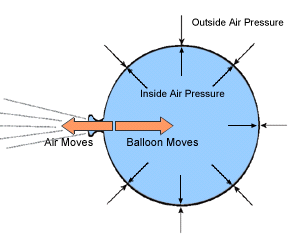We hope this and all knowledge is used for the benefit of humankind : to encourage us towards love and kindness and goodness.
Men have attempted to fly for a very long time. From the early attempts by Daedalus and his father to fly on wings to the Wright brothers men have wished to reach higher and higher.
In the early days of rocketry men floated or rose into the air by the use of balloons particularly hot air balloons. The earliest and simplest example or model of a balloon would be perhaps the sky lantern that rose up with a candle heating the balloon in the place of a closed paper structure (pictured).
 |
| Candle placed at the base of a balloon envelope (like an enclosed | lamp shade) |
The candle would heat the air inside the balloon which would then rise up with the candle and float into the air.
You can see the principles upon which a rocket flies if you blow air into a balloon , then hold the air filled balloon by pinching the opening of it, then release the opening of the air filled balloon and watch it "rocket" through the air. As we see in the following diagram this is the principle that makes a balloon "rocket" through the air :
It is on this principle that rocket engines are perhaps based upon: a souped up hot air balloon.
Following are figures illustrating the general idea behind a rocket engine. It illustrates how gases trapped in a sphere when given an outlet propel the object so:
 |
| As opposed to a balloon's envelope here the hot air pushes against the dome and exits via the nozzle propelling rocket forward |
 |
| Above is how a rocket works - very similar to how a hot air balloon might operate |
As you can see in a further illustration below hot air ignites in the dome , the air expands and then rushes out propelling the rocket in the opposite direction.
How do you create hot air inside the chamber of the rocket? we pass fuel into the "combustion chamber" (or dome which is the balloon's envelope equivalent) as we can see below we can pass fuel (and alternatively oxidizer like oxygen to cause an explosion) into the chamber so :
 |
| A simplified rocket Engine (oxidizer optional) |
Once we pass the fuel we ignite it in the chamber and cause the exhaust to flow out of the back of the engine thereby propelling the rocket forward.
If you are wondering how the ignition happens in an ignition chamber it is along the same lines as the ignition that happens in your car's internal combustion engine :

An animation showing how the internal combustion engine works is below :
 |
A Car's internal combustion engine
1) fuel comes in
3) the spark plug (of your car) ignites the fuel
4) the air expands and pushes the lever and
exhaust leaves through the other end after having
pushed the piston down
|
This is perhaps further proof that the internal combustion engine is entirely unsuited to use in a vehicle. To move the shaft or piston we have to ignite fuel . It makes sense in a rocket because you need sustained explosions (combustion) to lift off but it does not make sense in a land based transport (it is highly inefficient and over kill because an electric motor does the job much better) . But more on this later.
Essentially then all rockets are composed of dozens of hot air balloons at the bottom. With a hot air balloon there is only one "combustion chamber" :

As you can see the hot air balloon may have only one combustion chamber (or balloon) which rises when the air becomes hot. In contrast a rocket can have dozens of such combustion chambers (or engines) at the bottom helping lift up the rocket:
 |
| There can be dozens of engines at the bottom providing thrust |
Apparently the published status of rockets is that the USSR (now Russia) for some time had the most powerful rocket engines (with the highest thrust to weight ratio) because they are able to construct combustion chambers which can withstand the heat of some very oxidized explosions in the combustion chamber (whose "metallurgy they have perfected so these chambers can withstand the corrosive effect of oxygen rich pre burners"). Recently the
Merlin 1D a rocket engine developed by a private corporation just exceeded the decade+ old Russian NK-33.
Perhaps expenditure on space is useful because it may help us alleviate poverty, suffering and privation. However to set aside work against poverty , disease, labor, sustainability and scarcity and to work to escape earth and the solar system (particularly in anticipation of its demise) is incorrect
even if a "backup colony" argument is used.





















No comments:
Post a Comment